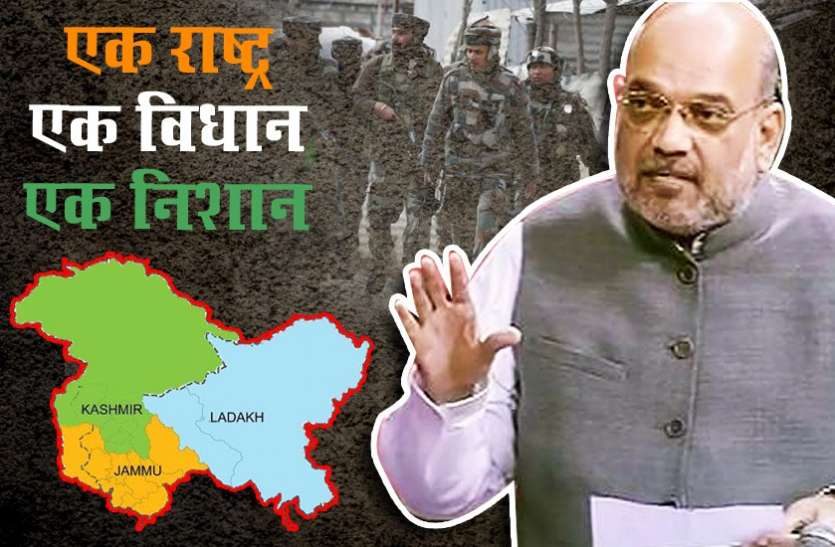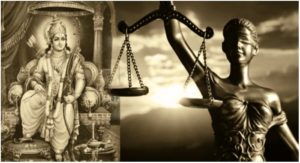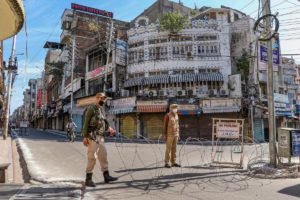(This article has been extracted by us from two articles: Jai Shankar Agarwala, “Article 370 of the Constitution: A Genesis”, Economic and Political Weekly, April 18, 2015; and “A.G. Noorani, “Article 370: Law and Politics”, Frontline, September 16-29, 2000.)
The princely states comprised almost half of the Indian territories in the subcontinent at the time of the proclamation of 1858 by the British colonial powers and their princes enjoyed full sovereignty in the internal matters subject only to the paramountcy of the British Crown. These territories together were referred to as “Indian India” in contrast to the rest of India, which by now had come to be known as “British India”—the territories directly administered by the British Crown.
The princely state of Jammu and Kashmir was one such state of the “Indian India” ruled by the Dogra lineage of kings under British paramountcy. Maharaja Hari Singh of this lineage was the ruler of “Jammu and Kashmir” during the turning point of the state’s history in 1947.
The Cabinet Mission of 1946 through their memorandum articulated clearly the policy of the new government towards the native princes on the withdrawal of British Rule from India. It affirmed that the rights surrendered by the Indian states to the British Crown would revert to the rulers of the states when the new dominions of India and Pakistan came into existence following the withdrawal of the British from India. The Cabinet Mission, however, advised the native states to evolve their relationship with the successor governments as the British would no longer be in a position to extend to them any protection. Legally speaking, the princely states of Indian India became fully independent with the lapse of British paramountcy on the coming into force of the Indian Independence Act, 1947 passed by the British Parliament, creating two dominions out of British India, namely, India and Pakistan.
The native Indian states numbering 565 at that time, of which Jammu and Kashmir was one, were now left with three choices: (i) to remain completely independent; (ii) to accede to India; or (iii) to accede to Pakistan. The power to make the choice was vested in the ruler of the state concerned. Jammu and Kashmir state which bordered both India and Pakistan and was ruled by Hari Singh, the then Dogra king, vacillated in making a prompt choice and did not sign the instrument of accession in favour of either India or Pakistan on the date of transfer of power by the British in August 1947. Perhaps, he harboured an ambition of keeping an independent existence, free from both India and Pakistan which eventually proved to be a costly political blunder for him and his people.
Accession to India
Peace in Kashmir was not to last long after the withdrawal of the British. Barely two months after independence, on 20 October 1947, a large number of armed tribesmen invaded Kashmir from the side of the border with Pakistan causing grave devastation and carrying out killings, rapes, loot and plunder in the Valley of Kashmir. Hari Singh was unable to meet the situation with his own forces. So, he had to give up his ambition of remaining independent, and decided to accede to India by an Instrument of Accession on October 26, 1947. The Governor General of India signed his acceptance on the instrument the very next day. The execution of the Instrument of Accession by the maharaja of Jammu and Kashmir and its due acceptance by the Governor General of India made the accession of Jammu and Kashmir to India final, complete and legally unassailable. For, the power to accede to any successor dominion of British India was vested in the ruler of the native state concerned and none else.
Under the Instrument of Accession signed by the ruler of Jammu and Kashmir, the state had acceded to India in respect of only three subjects—defence, foreign affairs and communications. A schedule listed precisely 16 topics under these heads plus four others (e lections to Union legislature and the like). The other subjects were retained by the ruler of the state of Jammu and Kashmir, to be governed in accordance with the Jammu and Kashmir Constitution Act 1939. Kashmir was then governed internally by its own Constitution of 1939.
Clause 5 said that the Instrument could not be altered without the State’s consent. Clause 7 read: “Nothing in this Instrument shall be deemed to commit me in any way to acceptance of any future Constitution of India or fetter my discretion to enter into arrangements with the Government of India under any such future Constitution.”
The Drafting of Article 370
The Maharaja made an Order on October 30, 1947 appointing Sheikh Abdullah the Head of the Emergency Administration, replacing it, on March 5, 1948, with an Interim Government with the Sheikh as Prime Minister. It was enjoined to convene a National Assembly based on adult franchise “to frame a Constitution” for the State.
Negotiations were held on May 15 and 16, 1949 at Vallabhbhai Patel’s residence in New Delhi on Kashmir’s future set-up. Nehru and Abdullah were present. Foremost among the topics were “the framing of a Constitution for the State” and “the subjects in respect of which the State should accede to the Union of India.” On the first, Nehru recorded in a letter to the Sheikh (on May 18) that both Patel and he agreed that it was a matter for the State’s Constituent Assembly. “In regard to (ii) the Jammu and Kashmir State now stands acceded to the Indian Union in respect of three subjects; namely, foreign affairs, defence and communications. It will be for the Constituent Assembly of the State when convened, to determine in respect of which other subjects the State may accede”.
During this period of time, the Constituent Assembly of India was engaged in the gigantic task of drafting the constitution, which was finally adopted and enacted on 26 November 1949 and put to effect on 26 January 1950 when India became a democratic republic in accordance with the Constitution of India. Unlike the 560 and odd states which took part in the deliberations and decided to fully integrate as states of the Union of India treaties, Jammu and Kashmir was not represented in the Constituent Assembly engaged in the drafting of the Constitution of India.
It was only in June 1949 that the Maharaja of Kashmir, advised by his council of ministers, nominated four representatives—Sheikh Abdullah, Mirza Mammad Afzal Beg, Maulana Mohammed Saeed Masoodi and Moti Ram Bagda—to the Constituent Assembly who also made it clear that the relationship between India and the state of Jammu and Kashmir was to be guided by the Instrument of Accesssion only.
As already stated, the Instrument of Accession with India conferred powers on the Union of India in matters of only external affairs, defence and communications. Internal administration was retained by the state as is evident from the Clause 8 of the instrument. The instrument was a standard text as engaged into by other native states as well. But while other native states voluntarily lost their independence in internal administration by signing supplementary treaties with India and by accepting in totality the Constitution of India, it was not so with Jammu and Kashmir. This special legal status of the state of Jammu and Kashmir was upheld by the Supreme Court in Premnath Kaul vs State of Jammu and Kashmir (A 1959 SC 749) and was again reaffirmed by the Supreme Court in Rehman Shagoo vs State of Jammu and Kashmir (A 1960 SC 1).
It therefore became necessary to accommodate Kashmir in the Constitution of India by providing a special provision. With the joining of representatives of J&K in the deliberations of the Constituent Assembly, negotiations began on this special provision, then called Article 306A, that later became Article 370. Article 370 was necessitated to accommodate the then prevailing legal status of the Jammu and Kashmir state in the body of the Constitution of India. It was only after all differences in the text of the resolution were resolved between Patel and Abdullah on October 16, that it was moved in the Constituent Assembly the next day (unilaterally altered by Ayyangar; in its original form, the draft would have made the Sheikh’s ouster in 1953 impossible).
Ayyangar’s exposition of Article 370 in the Constituent Assembly on October 17, 1949 is authoritative. “We have also agreed that the will of the people through the instrument of the Constituent Assembly will determine the Constitution of the State as well as the sphere of Union jurisdiction over the State. . . . You will remember that several of these clauses provide for the concurrence of the Government of Jammu and Kashmir State. Now, these relate particularly to matters which are not mentioned in the Instrument of Accession, and it is one of our commitments to the people and Government of Kashmir that no such additions should be made except with the consent of the Constituent Assembly which may be called in the State for the purpose of framing its Constitution.”
It is now part of undisputed history that the Constituent Assembly of Jammu and Kashmir was duly convened. While providing a constitution for itself, it also ratified the state’s accession to India on 15 February 1954. But the state of Jammu and Kashmir has a distinct status different from other Indian states inasmuch as it has reserved to itself all subjects relating to internal administration of the state transferring only the defence, external affairs and communications as per the Instrument of Accession and no more.
Betrayal
Unfortunately, events took a tragic course. The Sheikh was dismissed from office and imprisoned on August 9, 1953. (This sordid saga of manipulations and betrayal of the Kashmiri people is exposed in A.G. Noorani’s articles in Frontline, “The Legacy of 1953”, August 16–29, 2008 and “Brought to Heel”, August 30–September 12, 2008). On May 14, 1954 came a comprehensive Presidential Order under Article 370. Although it was purported to have been made with the “concurrence” of the State government it drew validity from a resolution of the Constituent Assembly on February 15, 1954 which approved extension to the State of some provisions of the Constitution of India. It certainly paved the way for more such Orders—all with “the concurrence of the State Government”, each elected moreover in a rigged poll. Ninetyfour of the 97 Entries in the Union List and 26 of the 47 in the Concurrent List were extended to Kashmir as were 260 of the 395 Articles of the Constitution.
Worse, the State’s Constitution was overridden by the Centre’s orders. Its basic structure was altered. The head of State elected by the State legislature was replaced by a Governor nominated by the Centre. Article 356 (imposition of President’s Rule) was applied despite provision in the State’s Constitution for Governor’s rule (Section 92). This was done on November 21, 1964. On November 24, 1966, the Governor replaced the Sadar-i-Riyasat after the State’s Constitution had been amended on April 10, 1965 by the 6th Amendment in violation of Section 147 of the Constitution.
Article 370 was used freely not only to amend the Constitution of India but also of the State. On July 23, 1975 an Order was made debarring the State legislature from amending the State Constitution on matters in respect of the Governor, the Election Commission and even “the composition” of the Upper House, the Legislative Council.
Article 370 had thus already been emaciated; all that had remained was the husk! Now, even the husk has been dumped into the dustbin.
(A.G. Noorani is an Indian lawyer, constitutional expert and political commentator. Jai Shankar Agarwala is an advocate at the Supreme Court of India.)




